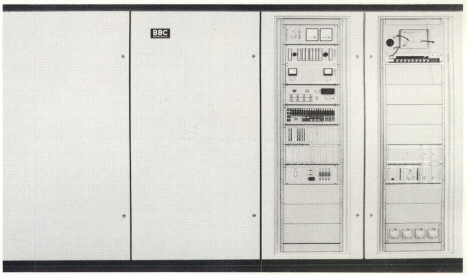| GENERAL DESCRIPTION |
 Introduction
Introduction| TECHNICAL SPECIFICATIONS | ||
| Carrier power output | 100 kW over full frequency range | |
| Frequency range | 5.9-22 MHz (extension to 3.9-26.1 MHz if required) | |
| Output impedance | 50 ohms unbalanced or 300 ohms balanced | |
| Permissible standing-wave ratio (SWR) | 1.7 at 300 ohms balanced output 2.0 at 50 ohms unbalanced output |
|
| Harmonic radiation | The harmonic radiation meets the requirements of the CCIR Radio Regulations (1976 Edition, Appendix 4) | |
| Modulation capability | a. Continuous sine-wave modulation between 100 and 5000 Hz - ten minutes per hour: 100% - fifty minutes per hour: 76% b. Short-period modulation between 50 and 10 000 Hz: 100% |
|
| AF response at nominal power output referred to m = 70% and f = 1000 Hz | a. With f between 60 and 7 500 Hz the response remains within +0.5 to -1 dB b. With f between 50 and 10 000 Hz the response remains with +1 to -2 dB |
|
| AF distortion | at nominal output power, m = 90% and f between 100 and 5000 Hz the distortion factor does not exceed 3% | |
| Carrier noise level below m = 100% | a. unweighted -55 dB b. weighted (CCITT Rec. P53) -65 dB |
|
| Carrier shift | with sudden application or removal of 100% modulation the variation in the carrier voltage will not exceed 5% (mains voltage drop excluded) | |
| AF input level | for m = 100% modulation, f = 1000 Hz across 600 ohms input impedance: 4 mW (+6 dBm) or 1 mW (0 dBm) | |
| Mains supply | 380 V, 3 phase a. Permissible voltage fluctuation: with TQ regulator ±10%, without regulator ±3% b. Mains frequency and tolerance (other voltages and frequencies if required): 50 Hz ±2 Hz |
|
| Mains power factor | not less than 0.9 at 100% modulation | |
| Overall efficiency a. at 0% modulation not less than b. at 30% sine modulation not less than c. at 100% sine modulation not less than |
3.9-15 MHz 66% 63% 60% |
15-22 MHz 65% 62% 58% |
| Required time for frequency change | SK 51 F3 about 3 minutes SK 51 C3 max. 1 minute |
|
| Specifications may change without notice | ||
| TUBE COMPLEMENT | |||
| RF stages | AF stages and modulator | ||
| Number | Type | Number | Type |
| 1 | CQK 50-2 | 2 | CQK 25-2 |
| 1 | CQL 2-1 | ||
| THIS TYPE OF TRANSMITTER IS INSTALLED IN THE FOLLOWING COUNTRIES | |||||
| ITU | Country | ITU | Country | ||
| BEL | BELGIUM | COD | CONGO DEMOCRATIC REPUBLIC | ||
| CUB | CUBA | DNK | DENMARK | ||
| EGY | EGYPT | ETH | ETHIOPIA | ||
| FIN | FINLAND | HNG | HUNGARY | ||
| IND | INDIA | IRN | IRAN | ||
| I | ITALY | KOR | KOREA SOUTH | ||
| MLA | MALAYSIA | MTN | MAURITANIA | ||
| MOZ | MOZAMBIQUE | HOL | NETHERLANDS | ||
| POR | PORTUGAL | RRW | RWANDA | ||
| SEN | SENEGAL | SRB | SERBIA | ||
| SNG | SINGAPORE | AFS | SOUTH AFRICA | ||
| SUI | SWITZERLAND | TZA | TANZANIA | ||